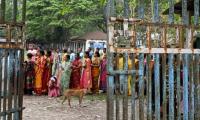The provincial government of Sindh and the federal government have agreed to construct a barrage on the River Indus at 45 kilometres upstream the Arabian Sea in the south of Thatta and in the east of Karachi to address environmental issues caused by sea intrusion and land degradation.
This consensus was reached at a high-power meeting held under the chairmanship of Sindh Chief Minister Syed Murad Ali Shah at CM House on Friday.
The federal government delegation led by Federal Minister for Water Faisal Vawda comprised Chairman Wapda Lt-Gen (retd) Mohammad Hussain, Mohammad Amin, GH (Hydro) Planning, Abid Shaikh, Chief Engineer-I (Hydro) Planning, Naeem Arif GM (Projects) South, and Col (retd) Nasir Ali Khan, Director Vigilance.
The Sindh government’s experts’ team comprised Irrigation Minister Sohail Anwar Siyal, Adviser to CM Murtaza Wahab, PSCM Sajid Jamal Abro, Special Assistant to CM Ashfaq Memon, former senator Dr Karim Khawaja, Special Secretary Irrigation Aslam Ansari, water expert Idrees Rajput, Chief Engineer Kotri Karim Wadoo, MD SIDA Wali Mohammad Naich and others.
Chief Minister Shah said that due to the non-availability of water downstream Kotri, sea intrusion had destroyed hundreds of villages in Thatta and Sujawal districts and also badly affected the delta, and as a result wetland habitats, mangroves’ growth had not only come to a standstill but had vanished away to a large extent.
He added that hundreds of families had migrated from the areas in search of livelihood. Federal Minister for Water Faisal Vawda and Chairman Wapda Lt-Gen (retd) Mohammad Hussain, giving a briefing to the chief minister, said that the Indus River was the largest river lifeline of Pakistan.
Indus River flows with mild gradient one meter per 18km. Downstream Kotri annual flows have been recorded at 27.9 MAF to sea. Flood protection bunds exist on either bank of the Indus River stretch and the flood plain is eight to 12km.
The Wapda chairman said that there was a plan to construct a 12-meter high barrage on the River Indus at a distance of 45km from sea. He added that dykes on either bank in flood plain would be four to nine meters’ high. The reservoir in flood plain from the barrage would be 160km upstream. There would be two canals on each side for irrigation and drinking water in the coastal area.
The Wapda chairman said that the right bank canal would be constructed from Ghorabari to Gharo and the left bank canal from Sujawal to Golarchi. At this, the chief minister said that the right bank canal should be constructed upto Dhabeji so that it could provide water for Karachi and the left bank canal may be taken upto from Golarchi to Thar to provide drinking water to the people of Thar.
The Wapda chief told the meeting that around 56,500 acres of land would be acquired which would include 55,000 acres for flood plain, 700 acres for the right bank canal and 800 acres for the left bank canal.
The chief minister said that since both the canals, would be taken upto Dhabeji and Thar, land acquisition would be more than 80,000 acres. The meeting was told that conceptual study by Wapda would be completed by August 2019, feasibility study would be done by September 2020, vetting for international consultants by December 2020, a detailed engineering design would be carried out by 2021, and project implementation would start in January 2022 and completed by December 2024.
The chief minister said that there would be displacement of various villages, therefore a plan for their rehabilitation or resettlement may also be included in the project.
Dr Karim Khwaja suggested that the people who had already lost their lands to sea intrusion should be compensated through the barrage project and the land to be reclaimed from the sea after the construction of the barrage must be given lands.
The chief minister said that the water to be stored would definitely make the nearby lands sweet, but simultaneously it would cause water logging in the area; therefore scientific arrangements must be explored to stop water logging and destruction of agricultural lands.
Water expert Idrees Rajput said that there was a proposal for the construction of a delta channel at Buharo to dispose of sea water in 1970, but it could not be implemented. He suggested to Wapda to construct a delta channel along with the project.
Special assistant to the CM Ashfaq Memon suggested constructing a coastal highway to further stop sea intrusion in the area. He also said that there must be a regulator to control the river water; otherwise it would inundate the nearby lands and destroy the other lands through water logging.
He also suggested constituting a oversee committee comprising experts of Wapda and the Sindh government to keep discussing the concept, the design and other relevant issues of the barrage so that it turned out to be one of the best projects in the country.
The chief minister said that there was a dire need to regulate the available flows downstream Kotri to provide drinking water, augment irrigation supplies, reduce sea intrusion, flood evacuation, increase sweat groundwater and improve ecology of the river.
The Wapda chairman said there would be storage of two to three MAF of water to utilise 4.1 MAF from available flows. It would make flood mitigation for surrounding 75,000 acres of land.
He said that the proposed barrage site was on the Indus River 180km downstream of Kotri, 45km upstream of the Arabian Sea, 65km south of Thatta and 130km east of Karachi. The chief minister directed Irrigation Minister Sohail Anwar Siyal to establish close coordination with the Wapda Chairman and form a committee to carry out spadework for the proposed dam.
An aerial view of Karachi city. — AFP/FileCelebrating ShakespeareThe National Academy of Performing Arts is...
This representational image shows a woman touching a dead body's legs. — APP/FileThe woman killed on Wednesday in...
The University of Karachi entrance gate. — APP/FileThe role of educated mothers is crucial for the development of...
Secretary Information Department Nadeem-ur-Rehman Memon. — Facebook/Umerkot - Gateway to TharSecretary Information...
Commissioner Karachi Syed Hasan Naqvi chairs a meeting to assess the preparations for the upcoming 29th International...
Sindh’s chief secretary Syed Asif Hyder Shah chairs a meeting with the National Highway Authority on April 18,...







